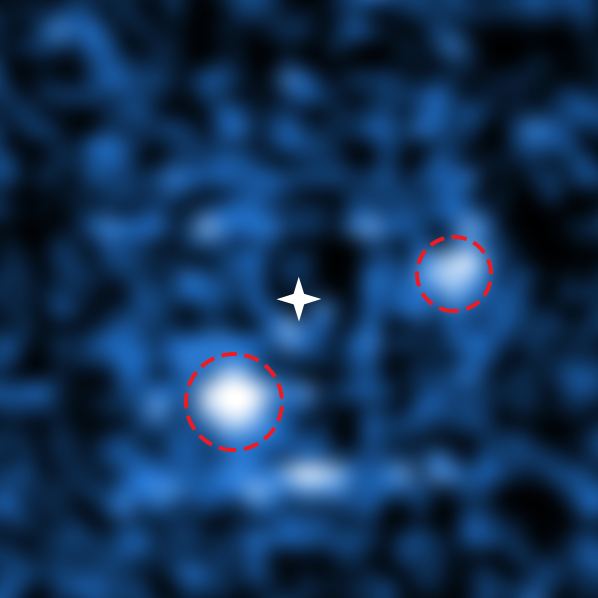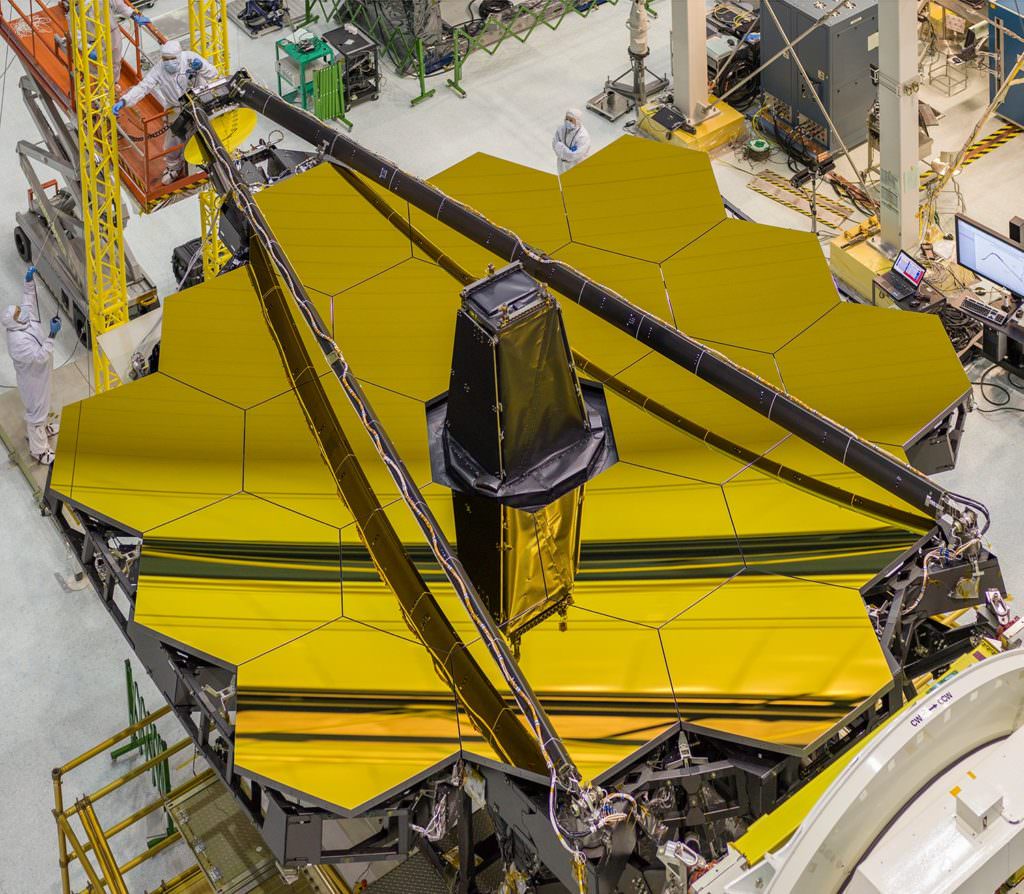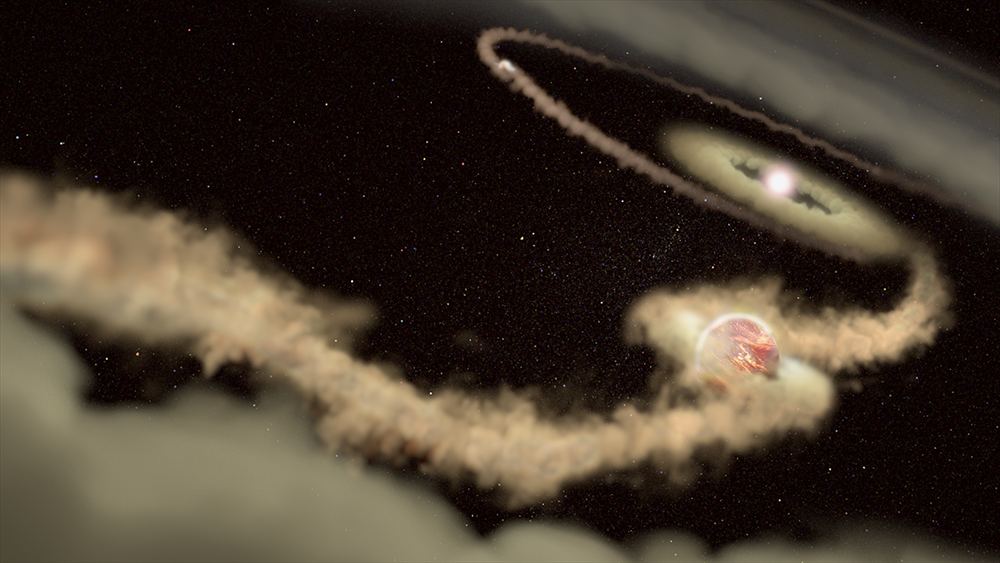370 light years away from us, a solar system is making baby planets. The star at the center of it all is young, only about 6 million years old. And its babies are two enormous planets, likely both gas giants, nursing on gaseous matter from the star’s circumsolar disk.
The host star in this system is called PDS 70. PDS 70 is a little smaller and less massive than our Sun, and is still accreting matter itself. This young star is a T Tauri star, which basically means they are very young and just starting out in life. Because it’s so young, planets are still in the process of forming in orbit around it. And seeing nascent planets still forming is something astronomers are only now starting to get good at.
“This is the first unambiguous detection of a two-planet system carving a disk gap.”
Julien Girard, Space Telescope Science Institute.
What makes the images of these young, still-forming planets interesting is that they’re evidence supporting our long-standing theory of how planets form in young solar systems. That theory is called the Nebular Hypothesis and it’s been around for decades, but without the observational evidence to back it up.
The Nebular Hypothesis
Stars form from massive clouds of mostly hydrogen called molecular clouds. Molecular clouds are gravitationally unstable and the gas tends to clump together. Eventually, one of these clumps starts snowballing and getting larger and larger. As it does so, the cloud flattens out like a pancake, and starts rotating, and when the central clump becomes dense enough, it ignites into a fusion and a star is born. Many stars are in binary systems, when two stars form from the molecular cloud.
But the star at the center isn’t the only clump. Other, smaller clumps form in the rotating gas, and they can form into planets. Some of the gaseous planets, like Jupiter and Saturn in our own Solar System, can get really big. (Astronomers sometimes refer to Jupiter and Saturn as “failed stars” because they were on their way to becoming stars but couldn’t quite get there.)
If you could freeze the process there, you would see a young star in the center of a flat, rotating cloud of gas. But in the gas you would see ring-shaped gaps, where planets are busy sweeping up material and becoming, well, planets. That process is called accretion. And it’s no longer a molecular cloud, now it’s called a “protoplanetary disk,” because it’s a disk shape and proto-planets are forming in it.
And that’s exactly what astronomers do see.

Seeing the Actual Planets
What’s cool about these new images is that we can not only see the gaps and rings that signal the presence of a planet, we can see actual planets themselves. And it’s only the second time we have for-certain seen a two-planet system making gaps in the disk. (A four-planet system called HR 8799 was imaged in 2008.)
“We were very surprised when we found the second planet.”
Sebastiaan Haffert, Lead Author, Leiden Observatory.
“This is the first unambiguous detection of a two-planet system carving a disk gap,” said Julien Girard of the Space Telescope Science Institute in Baltimore, Maryland.
In this new study, published in the June 3rd issue of Nature Astronomy, the team of astronomers used the MUSE Spectrograph on the European Southern Observatory’s Very Large Telescope (VLT.)
Seeing inside a protoplanetary disk is a tough task. Not only is the star really bright, dominating the image, but all of the gas and dust in the disk can block the light coming from the forming planets. The MUSE instrument has the power to sort of lock onto the light emitted by the hydrogen in the cloud, which is a sign of hydrogen accreting into still-forming planets.
“We were very surprised when we found the second planet,” said Sebastiaan Haffert of Leiden Observatory, lead author on the paper.
“With facilities like ALMA, Hubble, or large ground-based optical telescopes with adaptive optics we see disks with rings and gaps all over. The open question has been, are there planets there? In this case, the answer is yes,” explained Girard.

What the team spotted was a planet called PDS 70c. (Another planet in the same system, called PDS 70b, was first spotted about a year ago.)
The new planet, PDS 70c, is near the outer edge of the disk, and is approximately 3.3 billion miles from the star. That’s about the same distance that Neptune is from the Sun. Astronomers only have preliminary estimates of the planet’s mass, but they estimate that PDS 70c is between 1 to 10 times as massive as Jupiter.
The previously discovered planet, PDS 70b, is about 2 billion miles from the star, about the same as Uranus in our Solar System. It’s mass is between 4 to 17 times the mass of Jupiter.

Now We Wait. For the James Webb Telescope
Getting images of these young exoplanets is kind of a happy accident for the MUSE spectrograph. The instrument was initially developed to study galaxies and star clusters. But as it turns out, it’s good at spotting exoplanets in the process of forming. And that accident has helped moved the nebular hypothesis from hypothesis to accepted theory.
“This new observing mode was developed to study galaxies and star clusters at higher spatial resolution. But this new mode also makes it suitable for exoplanet imaging, which was not the original science driver for the MUSE instrument,” said Haffert.
In the future, (the future which keeps getting delayed,) the James Webb Space Telescope (JWST) will advance the study of young planets forming in these disks. Once the interminable wait for that advanced space telescope is over, its power should allow astronomers to zero in on very specific wavelengths of light that is emitted by accreting hydrogen.

That means that scientists will be able to measure the temperature of the hydrogen gas in the disk, as well as its density. Knowing both of those things will help us to really understand how gas giant planets form.
But for now, at least we have images of the planets, and when astronomers look out into the galaxy and see these young star systems, and the gaps in the disks, they can be confident that there are indeed planets there.

